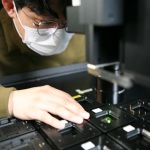- OLED panel reduces power consumption as much as 16 percent by speeding up electron flows in the display’s organic layers
- Less power consumption by the display panel can improve smartphone usage time
- Samsung Display now holds 5,000 material-related patents thanks to its ceaseless R&D in organic materials for OLED
SEOUL, South Korea–(BUSINESS WIRE)–#OLED_low_power–Samsung Display Company today announced a new low-power OLED display for smartphones that reduces power consumption up to 16 percent.


Samsung Display, the world’s largest OLED producer, developed the new OLED smartphone display after commercializing a just-developed organic material whose luminous efficiency has improved dramatically compared to the company’s previous OLED smartphone panels. The new panel is being used for the first time in Samsung Electronics’ Galaxy S21 Ultra smartphones.
OLED displays don’t require a separate light source, but instead produce their vibrant colors by running an electric current directly through a proprietary set of self-luminous organic materials. This is why the efficiency of organic materials plays a crucial role in determining an OLED display’s performance including its color gamut, high luminance, high-dynamic range imaging (HDR), outdoor visibility and power consumption.
“The constant progression of display technologies has increased demand for lower power consumption to enable features such as larger screens, faster display driving, and greater resolution,” said Jeeho Baek, Executive Vice President and Head of the Mobile Display Sales, Marketing & Product Planning Office at Samsung Display. “Building upon our industry-leading expertise in material technology, which has been increasing for a long time, Samsung Display is directly engaging with many of its customers to improve performance of their newest products,” he added.
Samsung Display’s novel organic material achieved its sharp increase in luminous efficiency by having electrons flow faster and more easily across the display’s organic layers. In other words, thanks to this process, OLED panels can create brighter light while consuming less power, which improves the battery lifetime for 5G smartphone users who spend more time watching video. The display panel is one of the most important components affecting a smartphone’s total power consumption. Therefore, when the display’s power consumption is cut, this can significantly impact smartphone usage time.
Samsung Display has been channeling much of its technological resources into securing “super-gap” competitiveness in the composition of more efficient organic display materials. To that end, the company has been closely collaborating with a number of global material companies, and widening its own talent pool in this field over the past decade.
Samsung Display now holds 5,000 patents worldwide that involve the use of organic materials for displays. Also, it has applied for more than 370 patents related to OLED organic materials in each of the past three years.
About Samsung Display
Samsung Display Co., Ltd. is a global leader in display panel market, with OLED and LCD technologies and products. Samsung Display has seven production facilities and five branch sales offices worldwide. The company specializes in high-quality displays for consumer, mobile, IT and industrial usage, including those featuring OLED (organic light emitting diode) and LCD technologies. As a total solution provider, Samsung Display strives to advance the future with next-generation technologies featuring ultra-thin, energy-efficient, flexible, and transparent displays. For more information, please visit www.samsungdisplay.com.
Contacts
John Lucas
for Samsung Display Company
j.lucas@partner.samsung.com




